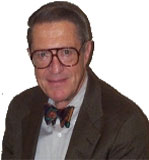Will They Ever Find a Cure for Asthma?
As a clinician and clinical scientist, and one who likes to speak to public groups, I am often asked the question, which is the title of this month’s newsletter. Yes, friends, there will be cures to most diseases, but let’s limit the discussion to the common problem of pulmonary disease.
Asthma is a problem for both the young and old, and it can be mild or severe. Air passages are obstructed with asthma both intermittently and chronically. New developments and understanding of basic asthma mechanism are being reported almost daily. The discovery of these mechanisms leads to new drugs and treatment strategies, which are equally important. Today, we recognize asthma as having two major factors, i.e., a bronchospastic factor when there is a sudden muscular narrowing of air passages, and an inflammatory factor which also narrows the air passages and creates mucus. A growing number of potent bronchodilators can open up air passages by relaxing these airway muscles. Today, there is more focus on methods of preventing or treating inflammation. In more pure forms of asthma, a drug Cromolyn (Intal) is an excellent preventative for many people. It is useful in both children and adults. It doesn’t do anything for established inflammation, however. Active inflammation requires our old “friends,” the corticosteroids, namely prednisone. In other newsletters, I have pointed out that prednisone is much more of a friend than a foe. It can be used strategically to combat active inflammation. Some individuals also require prednisone on a regular basis to prevent the progress of the disease. Inhaled corticosteroids, i.e., beclomethasone, bedenoside, flunisolide, fluticasone, triamcinolone, may also be effective in some patients with COPD, but mostly these are patients who primarily suffer from asthma. Additional drugs that are not related to the cortisone family are under study, and I am sure that within a number of years we will have alternate approaches to the problem of inflammation in bronchial asthma.
COPD is more persistent and progressive form of airflow obstruction and includes Asthmatic Bronchitis, Chronic Bronchitis, and Emphysema. Stopping smoking is the answer to prevention and progression of COPD. By stopping all smoking, the great majority of patients could avoid COPD altogether or could stop it in its tracks. Those patients with the rare form of congenital alpha 1 antitrypsin deficiency can now have a replacement therapy. The alpha antiproteinase is called prolastin. It requires weekly or possibly only monthly infusions. In effect, it is a cure because it replaces the basic deficiency. But, it is not for all forms of COPD. (Two other forms of treatment for alpha 1 deficiency have just been introduced).
Lung cancer is now the most common malignancy in both men and women. Smoking causes approximately 85% of lung cancer. Thus, we already have a cure for 100,000 men and 50,000 women who will get lung cancer each year! Stopping smoking is the answer to prevention. Otherwise, the cure for lung cancer is surgery, if it is possible. Chemotherapy and radiation are not very effective, but new lung cancer centers are being developed. These will focus upon early identification and intervention, and, of course, this will also mean smoking cessation. Hopefully, the newer drugs for lung cancer will be found more effective.
What about acute respiratory insults? The major lung disease spectrum cited here is the adult respiratory distress syndrome first described by the Denver group. This affects 150,000 patients each year. We are proud of the fact that 40-50% of ARDS patients survive, through therapies designed in Denver and now applied worldwide. We are also searching for better methods of prevention, and new drugs can help prevent acute lung injuries.

Dr. Thomas Petty, Professor of Medicine University of Colorado Health Sciences Center; Consultant and Faculty at HealthONE Center Denver, CO.




